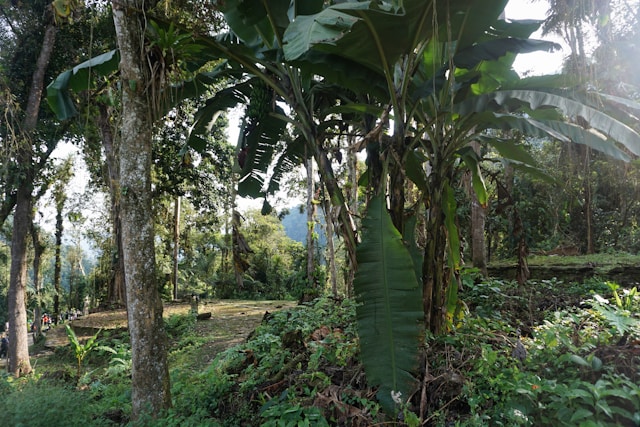
by DGR News Service | Aug 28, 2019 | Property & Material Destruction
By S.O.
Dear readers,
I am one of the researchers on the Underground Action Calendar. I really love it. I can’t help but smile when I read of efforts to try to destroy parts of the infrastructure of civilization. Around the world individuals are burning, bombing, dismantling and sabotaging telephone towers, electrical stations, pipelines, mines, communication cables, cyber networks and more!
But there is a problem in my research efforts at this time and I need your help. Specifically, there seem to be fewer and fewer publications of the incidents (action items) that I need for the calendar. I think that this problem is so pronounced now due to the current political climate in the U.S. where I live.
We are looking for published write-ups of completed attacks on infrastructure. In the past I used a global database (of “terrorist” incidents), which includes items through 2017. I feel that I have largely picked over that database. I am currently using several other sources, but they mostly seem to be limiting themselves to acts of protest and/or civil disobedience. While we recognize that these actions are necessary, they are not what we’re looking to include in the calendar.
Please send me info on or links to sources that you know of in your country. Thank you. Together we can turn the lights off!
About the Underground Action Calendar
The Underground Action Calendar exists to publicize and normalize the use of militant and underground tactics in the fight for justice and sustainability. We include below a wide variety of actions from struggles around the world, especially those in which militants target infrastructure, because we believe this sort of action is necessary to dismantle civilization. Listing an action does not necessarily mean we support or stand behind the goals, strategies, or tactics of those actionists.
This page highlights specific actions. See also our Resistance Profiles for broader information on the strategies, tactics, goals, and effectiveness of various historic and contemporary resistance groups.
If you know of a published action appropriate to add to the Calendar, contact us at newsservice@deepgreenresistance.org
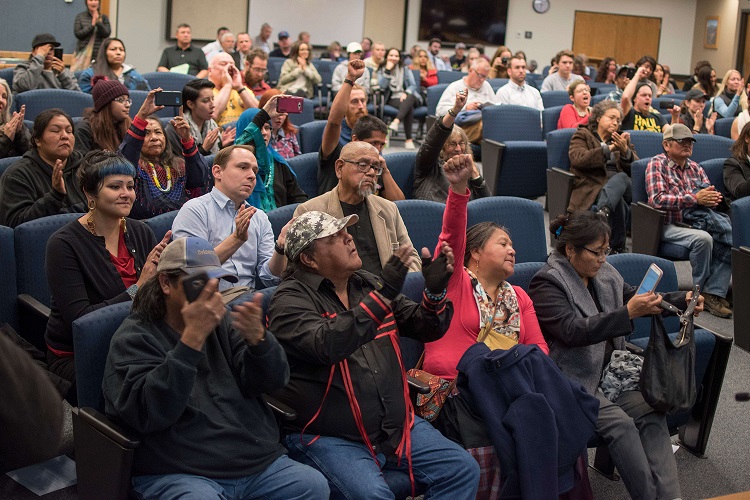
by Deep Green Resistance News Service | Mar 25, 2018 | Mining & Drilling
FLAGSTAFF CITY COUNCIL APPROVES RESOLUTION OPPOSING URANIUM MINING, DESPITE COMPANY CLAIMS
Featured image: Members of the Havasupai Tribe overjoyed to see the success of their resistance when the Flagstaff City Council announced their uranium hauling ban. Photo: Dustin Wero
by Garet Bleir / Intercontinental Cry
As the Canyon Mine’s operations to extract uranium ore adjacent to Red Butte edged closer to reality last November, Flagstaff’s City Council made the significant decision to oppose federal laws that would allow the transport of uranium ore through the Arizona city and the Navajo Nation’s territory. In Resolution No. 2017-38, the City Council went so far as to declare that it opposes uranium mining, while reaffirming its status as a Nuclear Free Zone and resolving “to actively work to advance social and environmental justice for the Indigenous Community.” This City Council’s bold move arrived at a crucial moment in the ongoing uranium mining debate, and it was most assuredly a win for everyone resisting the operations of Energy Fuels Resources.
More than 100 people were in attendance at the resolution vote. Many voiced their concerns about the proposal to transport large amounts of radioactive ore through communities like Flagstaff and across the Navajo Nation on its path to refinement. Members of the Havasupai, Navajo, Hopi, Apache, and Pueblo nations attended the meeting to express solidarity with the proposed motions.
Councilmember Eva Putzova issued a statement later on, saying, “With this resolution, the Council is rallying behind the Native American communities in their fight for social and environmental justice. I’m looking forward to working with our congressional representative and state representatives on legislation that bans uranium mining and the transport of uranium ore for good,” according to Haul No!, an activist and educational organization that’s fighting the uranium haul route.
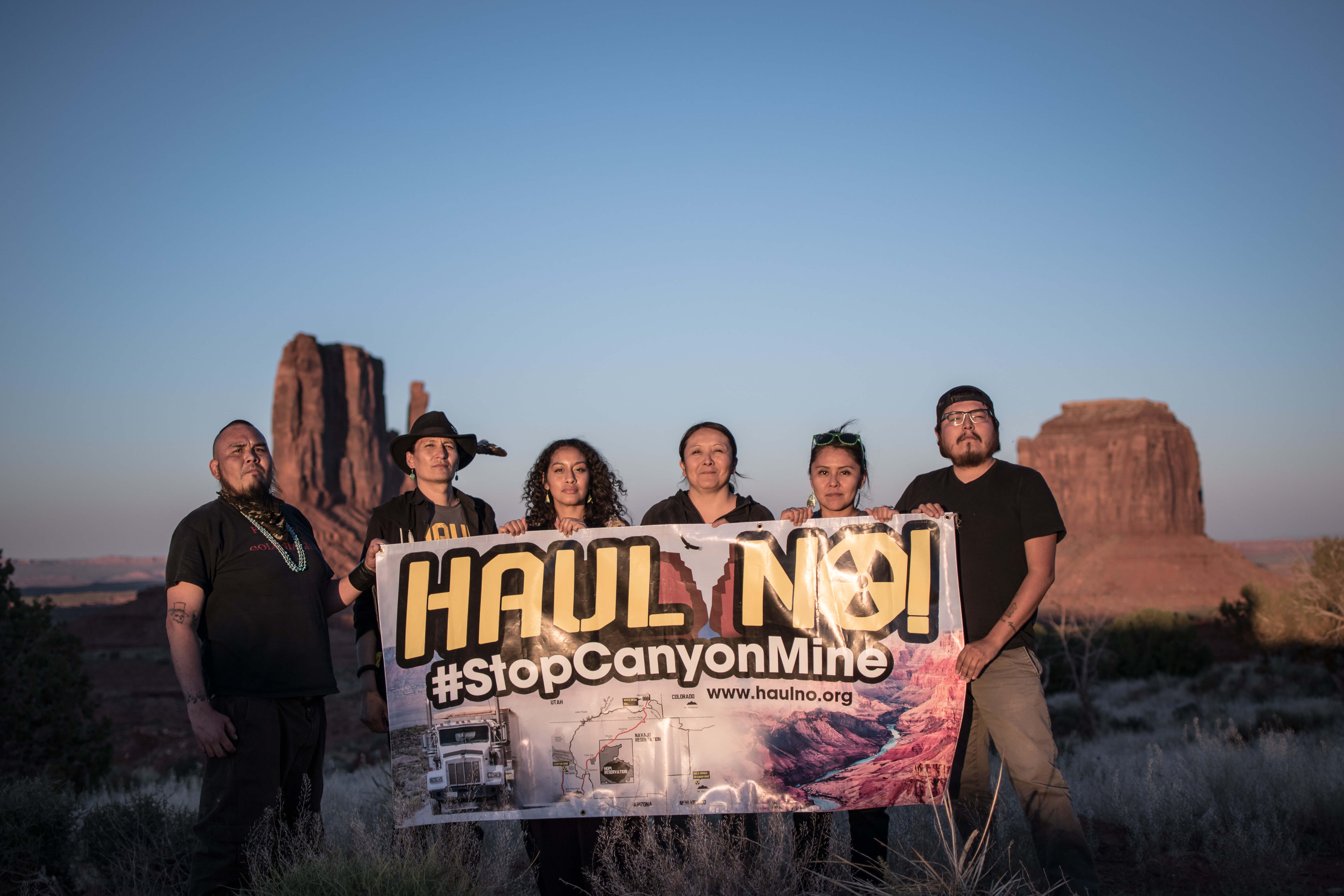
Representatives of Haul No! in front of Monument Valley on the Navajo Nation. Photo: Dustin Wero.
But while Flagstaff moved one step closer to impeding the uranium mining industry, the nation as a whole opened up even more protected lands to the resource extraction industry. During the fall season, Trump talked about letting more uranium mining around the Grand Canyon region. Then, in December 2017, he reduced Bears Ears and the Grand Staircase-Escalante national monuments, setting off what The New York Times predicted would be “a legal battle that could alter the course of American land conversation.” The decision opened millions of preserved public acres to oil and gas extraction, mining, and logging. One month later, he opened up land in Bears Ears National Monument for further resource drilling.
The nation recently learned about Energy Fuels Resources when documents obtained by The Washington Post showed that the company “launched a concerted lobbying campaign to scale back Bears Ears National Monument, saying such action would give it easier access to the area’s uranium deposits and help it operate a nearby processing mill.” Energy Fuels officials had pushed the White House to reduce Bears Ears as much as possible to minimally protect the “key objects and areas, such as archeological sites, to make it easier to access the radioactive ore.” The Canadian company has been designing similar plans that would result in the desecration of sacred spaces and practices—earning the attention of local conservation organizations focused on the Grand Canyon Region as covered throughout our series.
Indigenous communities know the history and the effects of nuclear colonialism. “My great-grandfather was a soldier who fought in Normandy, lived, and returned home to provide for his family,” said Sarana Riggs, a member of the Navajo Nation and the Native American Coordinator for the Grand Canyon Trust. Her great-grandfather worked at the Rare Metals Uranium Mill on the Navajo Reservation while facing the unknown dangers of radioactivity throughout his life. Riggs said the problem surfaced at its peak 10 years ago when he was suffering from pains that no one realized were due to stomach cancer.
Riggs great-grandfather soon passed away from the disease. The Rare Metals Mill has since been shut down, and houses around the mill were subsequently demolished due to documented health and environmental effects on nearby families and homes.
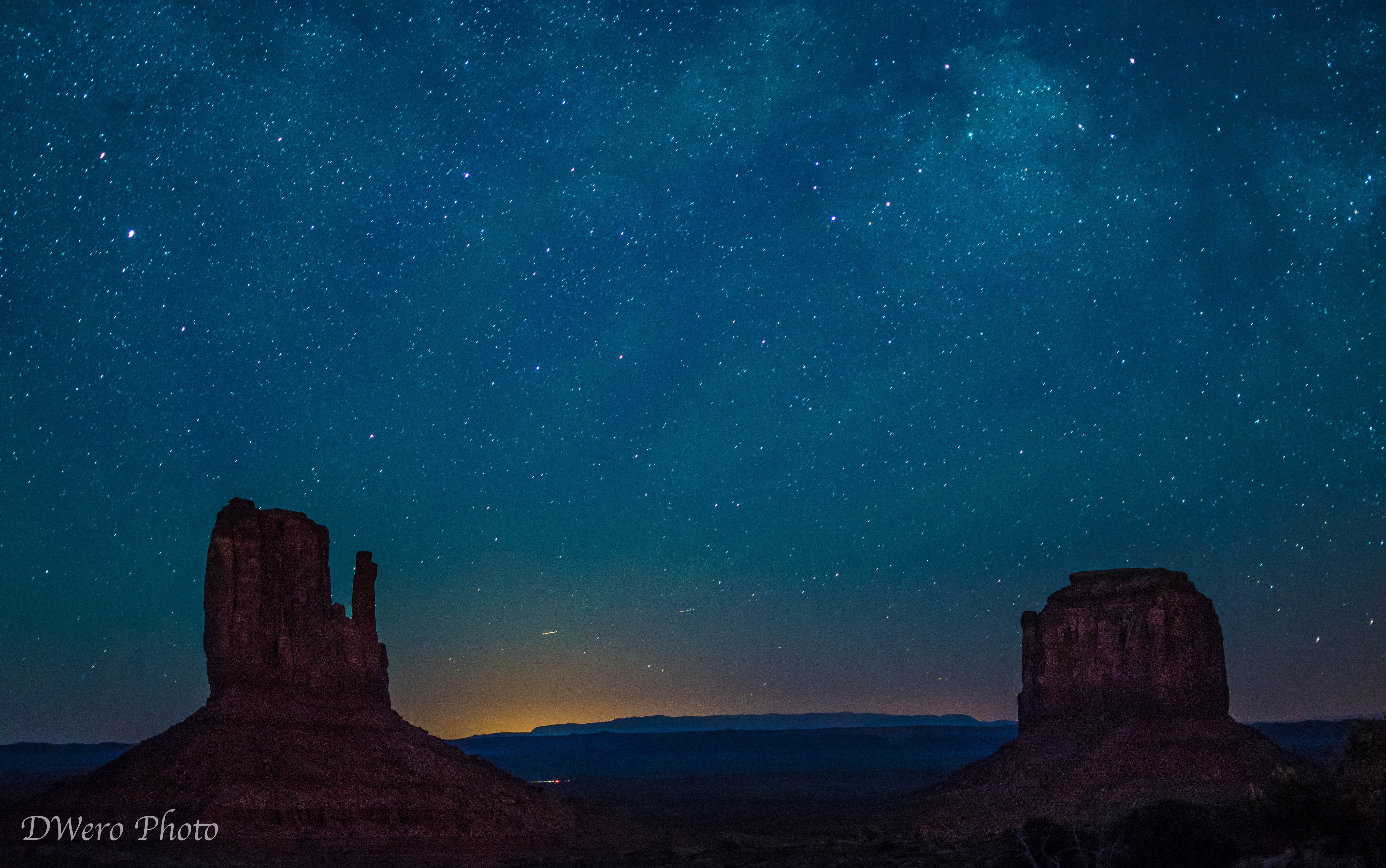
The Mitten in Monument Valley on the Navajo Nation. Areas like this are where the planned haul route will pass through. Photo: Dustin Wero.
Members of the Navajo Nation also struggle with the health repercussions due to the 523 abandoned uranium mines and 22 wells closed by the EPA due to high levels of radioactive pollution. According to the EPA, “Approximately 30 percent of the Navajo population does not have access to a public drinking water system and may be using unregulated water sources with uranium contamination.” A disproportionate number of the 54,000 Navajo living on the reservation now suffer from organ failure, kidney disease, loss of lung function, and cancer.
The Canyon Mine could have a similar impact on the Havasupai Nation and millions of Americans who depend on water from the Colorado River.
Riggs and others present during the Flagstaff City Council’s resolution meeting were relieved to see Flagstaff recognizing that members of the Navajo Nation and surrounding indigenous nations also make up the Flagstaff community. “Many travel over 80 miles to Flagstaff each day for work, school, or medical needs,” Riggs explained. “Flagstaff recognized the Navajo Nation, dealing with over 500 abandoned uranium mines, doesn’t need uranium hauling on top of that.”
The resolution was symbolic because the federal government, not the town of Flagstaff controls those roads. According to a press release by Haul No!, during the resolution meeting, Councilmember Celia Barotz reminded those in attendance that, “‘this is just the beginning, and we’re going to need all of you to help us through the various processes at the state and federal level if we’re going to make meaningful changes over the next several years.’” Borotz implored the community to remain engaged in the ensuing debate.
“With a unified voice of Flagstaff, Havasupai, Navajo, and Hopi communities, I hope representatives will address this,” said Riggs. “This isn’t U.S. land. They might have laws controlling Navajo highways, but ancestrally these are our lands. We’re upholding our rights. I’m looking at the Navajo Nation now to stand up, fight, and hold our leaders accountable because this is a threat to our health.”
Prior to the resolution, the Indigenous Environmental Network gave the city council a report detailing education, economic development, and social justice regarding Indigenous Peoples throughout Flagstaff, Riggs said.“The city hasn’t been so friendly to us native people. We’re more likely to get arrested or harassed by police and not always given the same treatment in businesses.” Following the report, the city council committed to addressing some of these problems. “The uranium transport resolution is one of the first steps,” said Riggs. “I hope the decision sets a precedent recognizing we have equal rights to everyone in Flagstaff.”
The final decision by the Flagstaff City Council was not without significant debate from both sides through months of town hall meetings. At one meeting this past July, the President and COO of Energy Fuels, Mark Chalmers, was in attendance to declare support for the mining operation. In defense of the project, Chalmers told the council that the uranium transported by Energy fuels is coming out of the ground in a natural state. “If you look at the Grand Canyon, and you looked at the Canyon Mine and the other uranium mines on the north side of the Grand Canyon, hundreds of these things have eroded naturally by the Colorado River over millions of years, hundreds of natural uranium deposit formations because the Grand Canyon cut through a zone of natural radioactive activity,” Chalmers said.
However, in a survey of 474 abandoned uranium mines on the Navajo Nation by the EPA, researchers have shown that 85 percent of those mines produced gamma radiation levels clocking in at twice the background level for the area. Furthermore, nearly half of the mines demonstrated radiation levels rising to 10 or even 25 times the background radiation.
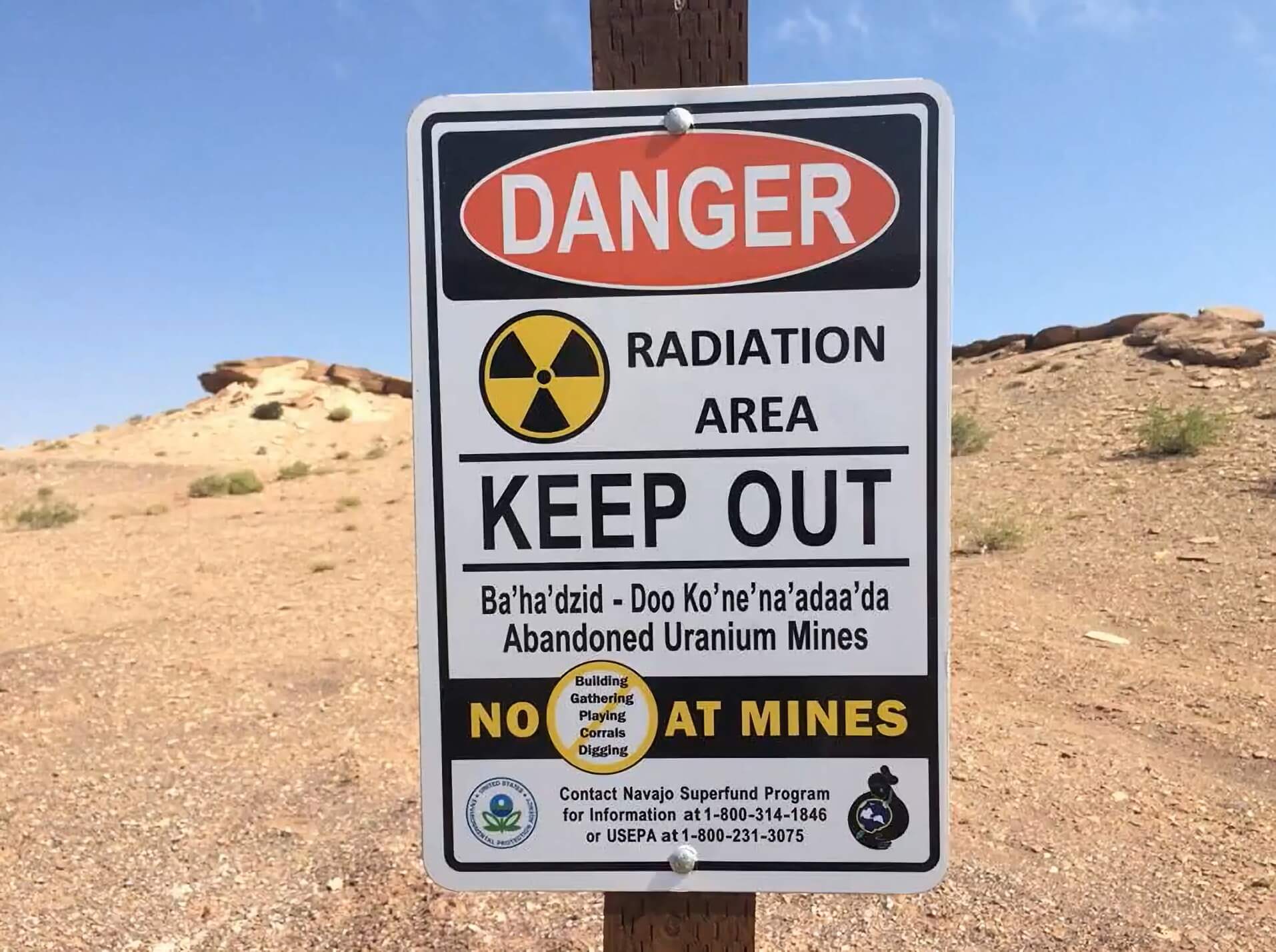
Radiation warning sign in front of A&B No. 3 Mine
Throughout his speech, Chalmers reiterated that the ore being transporting is not as dangerous as some of the other materials traveling through the city like sulfuric acid that could dissolve your hands or the “immediate hazards” that could be present with chlorine gas or fuels. “Whereas uranium ore you would just literally shovel it up, scan it, you’d make sure you cleaned it up, but it is not an immediate hazard,” said Chalmers. “I think that’s one stigma with uranium mining that they don’t fully understand.”
In an area plagued by the various remnants and continuations of nuclear colonialism, from the Church Rock uranium mill spill, to the documented health effects of uranium mining on the Navajo Nation, to the desecration of sacred sites without permission of the affected indigenous nations, the crowd was unresponsive to Chalmers claims.
Councilman Jim McCarthy responded to Chalmers’ assertions. A former member of the Grand Canyon Historical Society, McCarthy once attended a meeting at the rim of the Grand Canyon, overlooking the Orphan Mine uranium mine. “I asked the man who was giving the presentation who used to be the manager of that mine and I asked if there were any health effects on the miners,” McCarthy said. “He told me that’s the sad part, almost everyone who worked there got cancer and is dead.” Studies support that anecdote. According to the National Institute for Occupational Safety and Health’s mortality study on uranium miners, which began in the 1950s and has been updated several times through 2000, causes of death among this population that were significantly above average included lung cancer, pneumoconiosis (a type of lung disease caused by dust), tuberculosis, emphysema, and work-related injuries.
Chalmers told the audience that he also had friends who died of lung cancer from uranium mining but said that the industry had learned a lot in the last 50 years to combat that. “So does that mean that no one gets cancer anymore from these mines?” asked Coral Evans, the mayor of Flagstaff.
Chalmers attempted to respond. “Well, I mean, when you look at cancer, this is something that always drives me crazy. They say you get cancer from uranium or smoking or whatever, and then they haul you in and give you radiation to get rid of it,” Chalmers said. “People get cancer from different things, and I don’t think people really know all the reasons that people get cancer like if you’re at high altitude at 7000 feet, you get more radiation at 7000 feet than 1000 feet or 2000 feet.” Chalmers continued to argue that even with all the research surrounding cancer, there are unanswered questions as to what causes it and many contributing factors.
While Chalmers used the idea of unknown factors to support uranium mining, Mayor Evans used it as the very reason to support the hauling ban. “I just feel like I need to say this because this is something I feel is weighing heavily on me,” said Evans. The mayor reminded the audience of the people affected by U.S. nuclear bomb tests outside of Vegas in Nevada throughout the 30s, 40s, and 50s. “My mom was one of the individuals who were downwind of that, and as a result of her being a downwinder she died of breast cancer.”
Before that, Evans said there wasn’t cancer in her family. Evans has now had breast cancer twice, and her daughter, 23, is being tested by doctors annually. “They think something might have happened with this whole downwind thing and now it might be in our genes,” she added. “While we have changed, grown, and do things differently now, future generations pay for what has happened to the generations that came before, so I just want to make sure that we all understand that.”
The mayor’s points made a case for caution, emphasizing the many unknowns surrounding how uranium could affect generations to come and urging this generation to take the proper precautions to avoid destroying the lives of those yet to come. McCarthy, who has a masters degree in environmental engineering, said that he has a background in exploring issues like this and understands that even though we have learned a lot, risk analysis in these industries can be complicated.
According to a press release by Haul No!, “Right before the resolution went to vote, Flagstaff Mayor Coral Evans shared, ‘I want to talk about the constitutionality and legality part of it. In his ‘Letter from Birmingham Jail,’ Dr. King writes about something he calls just and unjust laws. I would say that in this country, historically we have seen several laws over the course of time be changed or overturned because we, the people, have determined that they were unjust.’
“Mayor Evans challenged all council members to pass the resolution with a 7-0 vote. ‘The legacy of uranium mining in Northern Arizona is unjust. I believe that it has been clearly shown through the routes that this ore takes… [and] clearly shown through the level of cancer and cancer-related death experienced by the indigenous people in our region. We have Indigenous neighbors that have been fighting and asking for relief on this issue for decades, for generations. And they are asking us, as the largest city in Northern Arizona, to help them.’”
by Deep Green Resistance News Service | Nov 24, 2013 | Colonialism & Conquest, Indigenous Autonomy, Mining & Drilling
By Ron Corben / DW
A new report on minorities and indigenous people warns that the global ‘intensification’ in the exploitation of natural resources is leading to mounting conflicts for the world’s 370 million indigenous people.
The report for 2012 by the London-based human rights group, Minority Rights Group International (MRG), says indigenous peoples “in every region of the world” face the risk of being “driven from their land and natural resources.”
The land and resources are all “vital for their livelihoods, their culture and often their identity as a people,” Vital Bambanze, chair of the UN Expert Mechanism on the Rights of Indigenous Peoples, said in the report.
From the Batwa of the Great Lakes region in Central Africa, and the Endorois and Ogiek in Kenya, to hill tribes in northern Thailand, Bedouin in the Middle East and Uighurs in China’s Xinjiang province – all “struggle to maintain their cultural integrity against their respective governments’ desire to put national development first,” Bambanze said.
Unprecedented demand for resources in Asia
The report says the unprecedented demand for natural resources across Asia is “feeding ethnic conflict and displacement and is a severe threat to the lands, livelihoods and the way of life of minorities and indigenous people.”
Carl Soderbergh, an MRG spokesperson, warns the situation faced by indigenous groups is deteriorating world-wide.
“In terms of the trends globally what has been happening over the last decade is that there’s been an intensification of the exploitation of natural resources pushing into areas populated by minorities and indigenous peoples,” Soderbergh told DW.
In regions such as Latin America, the issues faced by communities centered on mining and logging, in North America on tar-sands mining, there were conflicts over wind farms and iron ore mining in the Arctic, while in Africa, indigenous communities faced the leasing of thousands of hectares of land for corporations or foreign governments.
“All governments are chasing a dominant development paradigm in which today minorities and indigenous peoples don’t really have a place and that is a problem,” he said.
In China, investment in mining has forced herders off traditional grazing lands and ancestral villages in regions such as Xinjiang Uighur Autonomous Region, as well as in Tibet.
In Vietnam, over 90,000 people, mostly ethnic Thai, were relocated to make way for the Son La hydropower plant with Vietnamese scientists saying many were left without access to agricultural land.
Meanwhile, in Cambodia’s Prey Lang Forest region, home to the Kuy indigenous people, official land grants of tens of thousands of hectares of forest for mineral extraction, timber and rubber plantations have forced many people to give up their traditional livelihoods.
Conflict has also been evident in Indonesia in areas of increased palm oil plantation development and the mining industry in Papua.
Investment from China seen as a driver for economic growth
Nicole Girard, the rights group’s Asia Program Director, says levels of conflict over land is increasing in South East Asia, driven by foreign investment, including from China.
“It’s definitely increasing, the resource exploitation in indigenous people’s territories; in Southeast Asia, the economies of Laos and Vietnam are opening to more foreign investment, including lots of Chinese investment and including Burma,” Girard said.
Girard says the increased fighting in Myanmar’s ethnic controlled Kachin State over the past year is directly linked to conflict over resource investment largely by Chinese businesses.
Myanmar, led by the military-backed civilian government of President Thein Sein, has been undergoing reforms over the past year to improve its human rights situation. But Naw San, General Secretary of the Students and Youth Congress Burma (Myanmar) says despite steps to peace talks with ethnic groups in Myanmar, the development process is still not inclusive.
“We are still worried that, like in the past, investment and development projects will be dealt with by the central government and that there will be (no real) engagement or consultations with the process on the ground,” Naw San told DW.
“What the ethnic (communities) need now is national equality,” he said.
Two thirds of Indigenous People live in Asia
The Asia Indigenous People’s Pact (AIPP) Foundation, in a separate report, noted that two thirds of the world’s 370 million self-identified indigenous peoples live in Asia.
And those people, according to the AIPP Foundation, “are currently marginalized and subordinated economically, politically and culturally.”
They are “overrepresented among the poor, illiterate, malnourished and stunted,” it said.
AIPP’s report says for many in the region “militarization, (the) plundering of resources, forced relocation, cultural genocide and discrimination in everyday life are common experiences.”
The report pointed to the construction of dams in Asia, which since the 1960s, has led to “massive displacements, loss of livelihoods, and food insecurity of indigenous peoples in India, the Philippines, Laos and Malaysia.”
Bernice See, an AIPP coordinator, said governments give priority to economic ventures and investments over people’s rights.
See called on Asia’s governments to respect the UN’s Declaration of the Rights of Indigenous peoples and the provisions calling for the “free prior of informed consent from any development that comes into their territory.”
“These governments should have the moral obligation to respect these agreements. The declaration should be used as a framework for dealing with indigenous people,” she said.
From DW: http://www.dw.de/indigenous-peoples-threatened-by-resource-exploitation/a-16065981
by Deep Green Resistance News Service | Feb 27, 2012 | Indigenous Autonomy, Listening to the Land
By Catherine Saez, Intellectual Property Watch
The International Indigenous Forum, in an unprecedented collective move, decided yesterday to withdraw from the discussions of the WIPO Committee on Genetic Resources taking place from 14-22 February. The move calls into question the legitimacy of the negotiations.
As delegates were working on a compilation text at the twentieth session of the Intergovernmental Committee on Intellectual Property and Genetic Resources, Traditional Knowledge and Folklore (IGC), an Indigenous Peoples representative, speaking on behalf of the International Indigenous Forum, announced the withdrawal from active participation in the IGC.
In a statement [pdf in English], [pdf in Spanish] that the representative could not read in its entirety in plenary, the group said that Indigenous Peoples have participated as experts in IGC sessions, and worked in good faith. They have, according to the statement, “made efforts over the years to submit to the IGC sessions our collectively developed and sound proposals, which have been ignored or left in brackets in negotiation texts.”
As the “titleholders, proprietors and ancestral owners of traditional knowledge that is inalienable, nonforfeitable and inherent to the generic resources that we have conserved and utilized in a sustainable manner within our territories,” the group feels that “the discussion on intellectual property rights and genetic resources should include Indigenous Peoples on equal terms with the States since the work will directly impact our lives, our lands, our territories and resources.”
As a consequence, they said they decided “unanimously, to withdraw our active participation in the work developed by this Committee until the States change the rules of procedure to permit our full and equitable participation at all levels of the IGC.”
Under the current rules of procedures, Indigenous Peoples have observer status at the IGC. They can make proposals to the negotiations but those proposals have to be endorsed by at least one delegation to be taken into account.
Participation Being Eroded Gradually, Representatives Say
In an interview with Intellectual Property Watch, Indigenous Peoples representatives Debra Harry, executive director of the Indigenous Peoples Council on Biocolonalism, and Lucia Fernanda Jófej Kaingáng, the representative of the Instituto Indigena Brasileiro para Propriedade Intelectual (INBRAPI), said that since the beginning of the IGC the Indigenous Peoples’ participation has been narrowed and they have been excluded from key bodies like the “friends of the chair.” In this particular meeting, they were not able to participate in the team of facilitators drafting the negotiating text, they said.
Most of the textual proposals made by the Indigenous Peoples are not currently included in the present text, they said. The text that was actually taken into account is put forward in a way that does not reflect their original proposal, they added. For example, in Objective 1, paragraph 1.1.1., the current text says: “[including the sovereign rights of [States] nations and peoples, the rights of indigenous peoples and local communities, as well as private property rights] in accordance with domestic legislation [in patent applications].” Additions such as “states,” “private property rights,” and “patent applications,” have transformed the original proposal.
Change of the Rules of Procedure Needed, Indigenous Peoples Say
According to Harry and Jófej Kaingáng, the WIPO Legal Council told the Indigenous Peoples representatives at the last session that a change in the rules of procedure to allow full and equal participation would require a decision from the WIPO General Assembly. At present, the rules of procedure do not anticipate having Indigenous Peoples take an active part in the IGC, General Assembly or a diplomatic conference to discuss an instrument, they said. “For Indigenous Peoples, it does not make sense to participate in the IGC session but not be able to participate in the final stages of discussion” they said. Indigenous Peoples have been calling for a change in the rules of procedure since the 18th session of the IGC to no avail, they added.
“Instead, the WIPO Secretariat put forward a draft study [pdf] on the participation of observers in the work of the IGC, including nine proposals, none of which recommends a change in the rules of procedure to increase the participation of Indigenous Peoples or their level of participation,” Harry said. “States need to put forward some language that is asking for a change in the rules of procedures.”
“Indigenous Peoples participation brings legitimacy to the process and they need to have an effective and equal participation in all levels of the process: drafting groups, friends of the chair group, facilitators committee,” Harry said. Indigenous Peoples have collective rights under the United Nations system and states do not take those rights into account, according to the representatives. “We cannot participate in a process that undermines our rights,” Harry said. “If we cannot have a fair and effective participation, we are essentially participating in a process that will diminish our rights.”
In Brazil, 15 percent of the national territory belongs to Indigenous Peoples, and this territory is best conserved, said Jófej Kaingáng. “We are owners and holders of GR.” In Brazil, Indigenous Peoples have exclusive rights to use natural resources inside their land, and GRs are natural resources, she said.
Previously in the week, a representative from Tupac Amaru said that Indigenous Peoples’ proposals are not considered even when they are supported by governments. “We consider this discriminatory,” he said.
“Some Indigenous Peoples say they have the right to sit beside states that have colonised them,” said Ronald Barnes, who represents the Indian Council of South America (CISA). “Gaps and loopholes are being created that are not going to give us our rights,” he said.
Indigenous representatives during the week urged negotiators to “keep to the high standards” of the UN Declaration on the Rights of Indigenous Peoples,” and other international instruments. WIPO is a UN organisation.
“States are asserting national sovereignty over genetic resources, but state sovereignty is not absolute,” Harry said. “If the final instrument fails to recognise Indigenous Peoples’ rights, states may become gate keepers on our genetic resources and traditional knowledge and this would undermine our right to self-determination.” This right is inscribed in the international legal framework, for example in the UN International Covenant on Economic, Social and Cultural Rights, she said.
“If the outcome of this process is reached without our equal participation, we would consider the process to have no bearing on us.” Harry said.
IGC government delegates’ reaction to the withdrawal of the Indigenous Peoples group was generally one of “regret”, but no suggestions for addressing the concern, for instance by granting them equivalent status in negotiations.
From Intellectual Property Watch: http://www.ip-watch.org/2012/02/22/indigenous-peoples-walk-out-of-wipo-committee-on-genetic-resources
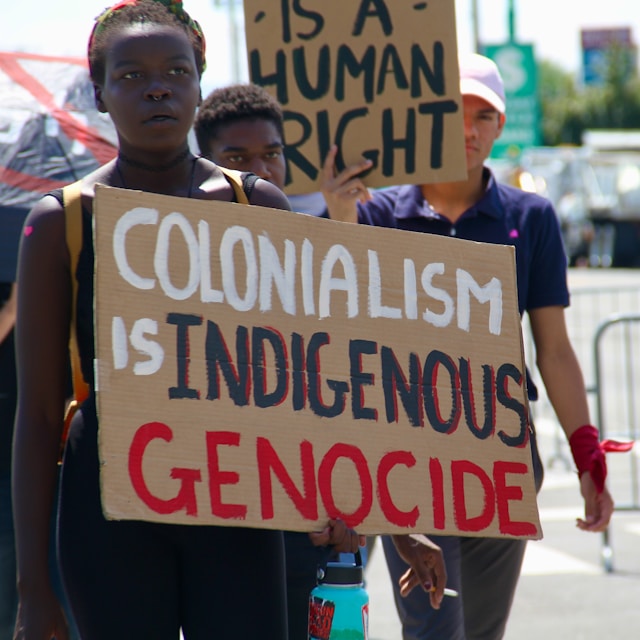
by DGR News Service | Jun 11, 2025 | Indigenous Autonomy, NEWS
Indigenous land defenders face rising threats amid global push for critical minerals
The past decade has seen “a consistent, sustained pattern against people who speak out against business-related human rights” abuses.
“This story was originally published by Grist. Sign up for Grist’s weekly newsletter here.”
Miguel Guimaraes, a Shipibo-Konibo leader, has spent his life protesting palm oil plantations and other agribusiness ventures exploiting the Amazon rainforest in his homeland of Peru. Last spring, as he attended a United Nations conference on protecting human rights defenders in Chile, masked men broke into his home, stole his belongings, and set the place on fire. Guimarares returned days later to find “he will not live” spray-painted on the wall.
The U.N. special rapporteur on human rights defenders, Mary Lawlor, denounced the attack and urged Peru to guarantee Guimarare’s protection. Although Guimaraes enjoyed international support, his assailants haven’t been identified.
Guimaraes is one of 6,400 activists who endured harassment or violence for defending human rights against corporate interests. That’s according to a new report from the Business & Human Rights Resource Centre that chronicles attacks and civil violations human rights defenders worldwide have experienced over the past decade. Although Indigenous people make up 6 percent of the world population, they accounted for one-fifth of the crimes documented in the report. They also were more likely than others to be killed, particularly in Brazil, the Philippines, and Mexico.
Some of these attacks arise from the “range of ways” governments are restricting civic space and discourse and “prioritizing economic profit,” said Christen Dobson, an author of the report and co-head of the Civic Freedoms and Human Rights Defenders Programme. “Over the past 10 years, we’ve seen a consistent, sustained pattern of attacks against people who speak out against business-related human rights, risks, and harms,” he said.
People like Guimaraes experience a wide variety of harassment, including judicial intimidation, physical violence, death threats, and killings. Most abuse stems from defenders raising concerns about the social and environmental harm industrial development brings to their communities and land. (More than three-quarters of all cases involve environmental defenders, and 96 percent of the Indigenous people included in the report were advocating for environmental and land issues.) The majority are tied to increased geopolitical tensions, a crackdown on freedom of speech, and the global minerals race, the report found.
Most of these attacks are reported by local organizations focused on documenting and collecting Indigenous cases, and the number of crimes against them may be higher. “The only reason we know about even a slice of the scale of attacks against defenders worldwide is because defenders themselves are sharing that information, often at great risk,” said Dobson.
Virtually every industry has a case in the database that the Business & Human Rights Resource Centre maintains. The organization has tracked companies, trade associations, and governments believed to have requested, or paid, law enforcement to intervene in peaceful protest activity. In 2023, for example, local authorities in Oaxaca, Mexico, attacked and injured members of the Union of Indigenous Communities of the Northern Zone of the Isthmus who were peacefully blocking the Mogoñe Viejo-Vixidu railway, which posed a threat to 12 Indigenous communities in the area.
The protest against the Dakota Access Pipeline saw the highest number of attacks related to a single project over the last decade, the report found. Around 100,000 people in 2016 and 2017 gathered to oppose the pipeline and were met with a campaign of harassment, intimidation, and arrest. Energy Transfer, the company that led the project, filed a defamation suit accusing Greenpeace of violating trespassing and defamation laws and coordinating the protests. In March, a jury ordered Greenpeace to pay $660 million in damages, a verdict legal experts called “wildly punitive.”
The Business & Human Rights Resource Centre cites that lawsuit as an example of companies using a legal tactic called a strategic lawsuit against public participation, or SLAPP suit, to silence dissent and harass protesters. But Energy Transfer cited that courtroom victory in its response to the nonprofit’s report: “The recent verdict against Greenpeace was also a win for the people of North Dakota who had to live through the daily harassment and disruptions caused by the protesters who were funded and trained by Greenpeace.”
Fossil fuel companies were hardly the only offenders, however. Dobson and her team identified several cases involving renewable energy sectors, where projects have been linked to nearly 365 cases of harassment and more than 100 killings of human rights defenders.
But mining, including the extraction of “transition minerals,” leads every sector in attacks on defenders. Forty percent of those killed in such crimes were Indigenous, a reflection of the fact that more than half of all critical minerals lie in or near Indigenous land.
The outsize scale of harassment and violence against Indigenous people prompted the U.N. special rapporteur to release a statement last year making clear that “a just transition to green energy must support Indigenous peoples in securing their collective land rights and self-determination over their territories, which play a vital role in biodiversity, conservation, and climate change adaptation.“
Businesses, particularly those in mining and metals, are being pressured to ensure their operations do just that. The Consolidated Mining Standard Initiative, or CSMI, for example, is a voluntary framework to improve industry policies adopted by several trade associations like the Mining Association of Canada. “The standard addresses a broad range of community risks by requiring mining operations to work with communities to identify and work together to mitigate risks faced by the community,” the association said. “Such risks include those to human rights defenders, where they exist.”
Another member of the initiative, the International Council of Mining and Metals, said it has “strengthened our member commitments on human rights defenders to explicitly include defenders in companies’ due diligence, stakeholder engagement, and security processes. Defenders often work on issues related to land, the environment, and Indigenous peoples’ rights.”
Even as this report highlights the dangers human rights defenders face, a growing need for critical minerals, mounting demand for the infrastructure to support AI, and the dismantling of regulatory oversight in the United States bring new threats. The report also makes clear that these attacks will not decrease until broad agreements to adopt and implement protections for these activists are enacted. Such policies must be accompanied by legislation designating Indigenous stewardship of their land and requiring their involvement in project consultations.
Yet Indigenous organizations tend to doubt any industry can be trusted to voluntarily participate in such efforts. In a letter sent to the CSMI, 25 human rights organizations including the Business & Human Rights Resource Centre said mandatory participation will be required to ensure robust protection of human rights defenders and relationships between industry and Indigenous peoples. “People and the environment suffer when companies are left to self-regulate with weak voluntary standards,” the letter stated.
Still, change is coming, however slowly. When Dobson and her team started tracking the harassment and violence against human rights defenders, she wasn’t aware of any companies with a policy pledging to not contribute to or assist attacks against defenders. Since then, “We’ve tracked 51 companies that have made this policy commitment,” she said. “Unfortunately that doesn’t always mean we see progress in terms of implementation of those policies.”
This article originally appeared in Grist at https://grist.org/indigenous/indigenous-land-defenders-face-rising-threats-amid-global-push-for-critical-minerals/.
Grist is a nonprofit, independent media organization dedicated to telling stories of climate solutions and a just future. Learn more at Grist.org
https://www.googletagmanager.com/gtm.js?id=GTM-TG2PKBX
Photo by Datingscout on Unsplash







